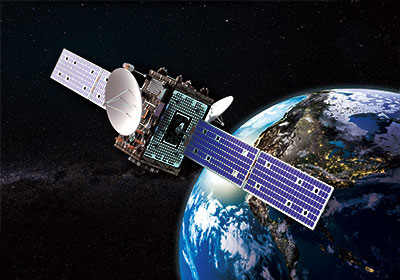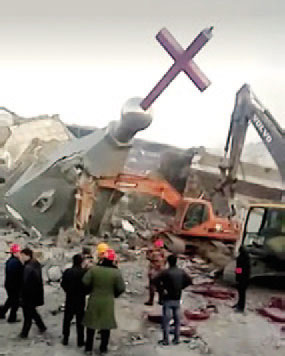5 Battlegrounds for U.S.-China Cold War Trade War to Space War
Part 2
【Battleground 3: Finance】
Challenging the People’s Liberation Empire
China is in the process of constructing an Empire with their trade surplus. Trump is putting a stop to that.
U.S. President Donald Trump has imposed trade tariffs against China and demands a cut of $200 billion to the trade deficit by 2020.
The Beijing government uses a fixed exchange-rate system where the Chinese Yuan is fixed against the currencies in their foreign exchange reserve (primarily the USD).
In other words, the greater their trade surplus and foreign investments into China, the greater the growth of their foreign exchange reserves, meaning the more reliable the Yuan becomes. This allows the People’s Bank of China to print more money.
China assumes the guise of a capitalist country, but in reality, both the Central Bank of China and Industrial and Commercial Bank of China are under the control of the Communist Party.
That is, the Communist Party decides where the newly printed money goes. For instance, the Party can decide to spend that money on the People’s Liberation Army, or invest in companies that can steal advanced technology from overseas.
They could invest in infrastructure to artificially boost the economy. Or they could spend that money on developing military equipment such as aircraft carriers and stealth fighters, or build man-made islands in the South China Sea to construct military facilities.
Trump is now trying to stop this movement.
“[Trump’s strategy] is to cut off China’s supplies before having to resort to armed conflict,” explains Master Ryuho Okawa, Founder and CEO of Happy Science. China’s primary military funds come from their dollar reserves accumulated from the trade surplus against the U.S.
Trump’s tariffs are aimed at cutting off that financial source.
As Tetsuya Watanabe said in the interview in Part 1, China’s military budget is already showing signs of shrinkage because China’s domestic investors who fear the weakening Yuan are exchanging it for the dollar.
The People’s Bank of China is barely keeping the Yuan afloat by selling their dollar reserves, but once the reserve hits the bottom, the Yuan will come crashing down.
Hyperinflation: there will not be enough Yuan’s to circulate around the country and companies will run short of funds; the government will no longer be able to continue expanding their military; nor will they be able to buy advanced technology, food supplies and energy resources from foreign countries; food prices will rise; and the people will be in an uproar.
From there the fall of the political system will be rapid. Trump is thus challenging the People’s Liberation Empire, eagerly awaiting the day when Xi Jinping will raise his hands in surrender.
【Battleground 4: Space】
The U.S.-China Battle in Space
From Trade War to Space War
The Chinese military is currently working on space technology development. Meanwhile, in August, the Trump administration announced a goal to create a military Space Force by 2020. Both China and the U.S. are competitors in advanced technology development and are exerting a lot of energy on space technology.
Future wars will take place out in space, and they will begin and end before people even realize.
Satellite Attacks Cause Panic
Artificial satellites are prime targets during a space war. If the enemy destroys our satellites, people on the ground will be thrown into panic.
TV, cell phone and Internet services will stop, and ATMs will begin to malfunction. The world financial market will freeze, and electric power plants will cease operating. Traffic lights will start misbehaving, paralyzing the transportation network. GPS navigation will stop working so planes will stop flying.
This is not science fiction: it is the potential danger that the U.S. is calculating on the chance that they will engage in a space war with China.
China Improves Target Accuracy
What the U.S. fears most is China’s developing satellite-destroying weapon.
In 2007, China succeeded in hitting a satellite practice-target with their new satellite-destroying missile. This was not the only test they performed. For a long time, China has been developing weapons to destroy satellites from the ground, and laser weapons that can target the ground from out in space.
There are a variety of ways to target artificial satellites: cyber-attacks, laser weapons, small “killer satellites” that approach and explode near enemy satellites, ballistic missiles and nuclear weapons.
China has already attacked U.S. reconnaissance satellites by aiming lasers at them to disrupt operations and cyber-attacking them. Some analysts even claim that China’s satellite attacking abilities have surpassed the U.S.
Additionally, China aims to launch their space station, Tiangong, in 2022. The huge investment will become a base from which China plans to dominate the thermosphere.
Next their aim is to investigate Mars and to build a base on the Moon. Once the People’s Liberation Army succeeds in dominating space, they will push their hegemony further out to the Moon and to Mars.
The U.S. Air Force is now developing space weapons such as the “Rods from God” to stop China’s dangerous ambitions. “Rods from God” is a tactic where very hard metal rods, such as tungsten, are dropped down to Earth from space. The impact is comparable to a nuclear weapon.
The U.S. and China are, this very moment, competing to see who will dominate space.

Interview
Japan to Independently Develop Space Defense

Seiji Kawada
Former Japan Air Self-Defense Force Officer
Born in 1967 in Gifu Prefecture, he graduated from the National Defense Academy of Japan before becoming a pilot at the Japan Air Self-Defense Force. He currently holds a teaching position at Happy Science University in International Politics and Security.
The reason why the U.S. and China are competing in their preparation of a space force is because modern warfare cannot happen without artificial satellites and space technology.
For example, one U.S. Carrier Strike Group spreads over roughly 20,000 km2. So, to create formations across such a vast area requires the aid of a satellite communication systems such as a GPS.
Advanced technology is the U.S. military’s forte, but their reliance on space-related technology also makes it their weakness.
China thinks that ruling space means attaining military predominance. So, their aim is to become the most powerful country out in space, and in order to do that they have a strategy to fuse the air and space forces. One of their most important technologies is their laser weapon that can destroy or force-stop enemy satellites from the ground. This kind of technology is more advanced that in the U.S.
Japan and The Lost 40 Years
Thus the U.S. and China are having a face-off in space technology developments. Meanwhile, Japan is falling far behind.
Here’s the story. Back in 1967 they signed the Outer Space Treaty. The treaty placed limits on the investigation and appropriation of space, such as prohibiting all countries from placing weapons of mass destruction in the Earth’s orbit.
At the time, the National Diet in Japan interpreted this ‘space peace treaty’ to mean an ‘anti-military space treaty’, and henceforward placed its own limitations on space technology developments.
This view only changed in 2008 when the government legislated the Basic Space Law and announced the Basic Space Plan, finally acknowledging the use of space technology for security purposes. Specialists call this period of Japan’s anti-military space developments “The Lost 40 Years”.
The U.S.-Japan Security Treaty Does Not Apply to Space
The Japanese people, however, still think that if something happens to threaten national security, the U.S. will come and help.
The U.S.-Japan security treaty, however, is an agreement that is only activated if Japanese territory is invaded, and does not apply to the sea or outer space. In other words, it is unlikely that the treaty will apply for Japanese satellites.
Communications satellites are a must if the Self-Defense Force needs to protect things that are long distances away, such as the Senkaku Islands. And if we cannot rely on the U.S. to protect Japan’s satellite, then Japan must develop her own defense systems.
Our nearest opportunity is to include a space defense strategy in the New Defense Network policy scheduled to be announced later this year. Japan also needs to extend the defense budget and actively participate in space developments.
【Battleground 5: Ideology】
Exporting Religious Freedom for Democratization
President Trump isn’t just outraged about the trade deficit and the misappropriation of intellectual property. He is also appalled by China’s inhumane religious persecutions.
Ever since his presidential campaign, Trump has constantly been advocating the return of religious freedom for the country. The idea of creating a country based on religion and faith in God is what drives the Trump revolution.
And Trump has started to export that ideology out to the world. In July, the Department of State hosted the Ministerial to Advance Religious Freedom, inviting clerics and NGO representatives from over 80 countries around the world. It was a demonstration of America’s initiative in taking leadership in realizing worldwide religious freedom.
Tahir Hamut, the Uyghur filmmaker who recently became a religious refugee in the U.S., gave speech where he compared the Beijing government’s Xinjiang “re-education camps” to the Nazi concentration camps during WWII.
The Potomac Declaration that was adopted at the Ministerial states that “Defending the freedom of religion or belief is the collective responsibility of the global community.” These remarks are undoubtedly aimed at China.
China is persecuting clerics and believers under their goal for the “Sinicization of Religion.” They erase God from religion instead teaching that people can be saved if they worship heroes such as Mao Zedong. The church is turning into a propaganda institution for the Communist Party.
So China is in no condition to comprehend the concept of human rights. Trump insists on cutting the trade deficit to politically and economically destabilize China, which will ignite the desire for freedom in the hearts of the people, and lead the country to democratization.
As we can see, Trump’s battle against China is unfolding over many areas including trade, intellectual property, finance, military and ideology.




















